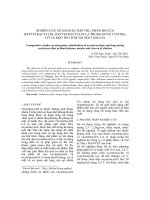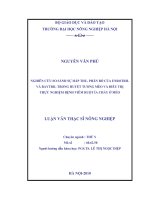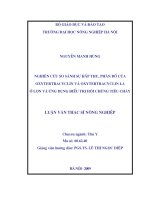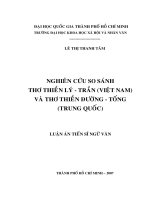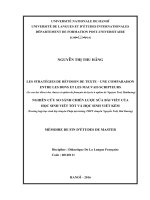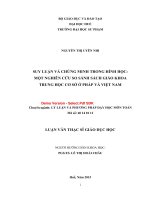NộI địa hóa và ngoạI lai hóa trong dịch tên riêng nghiên cứu so sánh hai bản dịch tiếng việt của the fellowship of the ring
Bạn đang xem bản rút gọn của tài liệu. Xem và tải ngay bản đầy đủ của tài liệu tại đây (703.47 KB, 61 trang )
DOMESTICATION AND FOREIGNIZATION IN TRANSLATING PROPER NAMES
VIETNAM NATIONAL UNIVERSITY, HANOI
UNIVERSITY OF LANGUAGES AND INTERNATIONAL STUDIES
FACULTY OF ENGLISH LANGUAGE TEACHER EDUCATION
GRADUATION PAPER
DOMESTICATION AND FOREIGNIZATION IN
TRANSLATING PROPER NAMES
A comparative study on the case of Vietnamese translations of
J.R.R.Tolkien's "The Fellowship of the Rings"
Supervisor : Nguyễn Thị Diệu Thúy
Student
: Phạm Thị Quỳnh Anh
Course
: QH2011
Hanoi, 2015
DOMESTICATION AND FOREIGNIZATION IN TRANSLATING PROPER NAMES
ĐẠI HỌC QUỐC GIA HÀ NỘI
TRƯỜNG ĐẠI HỌC NGOẠI NGỮ
KHOA SƯ PHẠM TIẾNG ANH
KHÓA LUẬN TỐT NGHIỆP
NỘI ĐỊA HÓA VÀ NGOẠI LAI HÓA
TRONG DỊCH TÊN RIÊNG
Nghiên cứu so sánh hai bản dịch Tiếng Việt của
“The Fellowship of the Ring” – J.R.R.Tolkien
Giáo viên hướng dẫn: Nguyễn Thị Diệu Thúy
Sinh viên: Phạm Thị Quỳnh Anh
Khóa
: QH2011
HÀ NỘI, 2015
DOMESTICATION AND FOREIGNIZATION IN TRANSLATING PROPER NAMES
I hereby state that I: Pham Thi Quynh Anh, QH2011.F1.E20, being a
candidate for the degree of Bachelor of Arts (TEFL) accept the requirements
of the College relating to the retention and use of Bachelor’s Graduation
Paper deposited in the library.
In terms of these conditions, I agree that the origin of my paper deposited in
the library should be accessible for the purposes of study and research, in
accordance with the normal conditions established by the librarian for the
care, loan or reproduction of the paper.
Signature
Date
DOMESTICATION AND FOREIGNIZATION IN TRANSLATING PROPER NAMES
CONTENT
Table of contents
Page
Acknowledgements …………………………………………….……………....i
Abstract ………………………………………………………………………..ii
List of figures, tables, and abbreviations………………………...……………iii
Chapter I: Introduction
1.1. Statement of the problem and the rationale for the study…….……..…..…1
1.2. Aims and objectives of the study…………………………………...…..….4
1.3. Scope and significance of the study.………………………………...……..5
1.4. Organization……..….…………………………….……………….…….....6
Chapter II: Literature Review
2.1. Proper Names………………………….………………………………......7
2.1.1. Proper Names in general………………………………….……......7
2.1.2. Proper Names in fantasy literature………………………...….…....7
2.1.3. Proper names in Tolkien’s Lord of the Rings……… ......................8
2.2. Domestication and Foreignization…….……………………………..…....9
2.2.1. Venuti’s Domestication and Foreignization…………………..…....9
2.2.2. Factors influencing domestication or Foreignization ………...…..10
2.2.3. Theoretical Framework and Models…....……………….........…...12
Chapter III. Research methodology
3.1. Selection of subjects……………….….………….………………..…....17
3.2. Procedures of data collection…….……………….……………….…....17
3.3. Procedures of data analysis…….……………………………..………...18
Chapter IV. Findings and Discussions
DOMESTICATION AND FOREIGNIZATION IN TRANSLATING PROPER NAMES
4.1. Translators’ use of domestication and foreignization in translating proper
names..…………………………………………………………………...…....19
4.2. Explain author's motivations…….………………………….……..….....29
4.3. Discussions…….……………………………………………...…..…......37
Chapter V: Conclusion
5.1. Summary of findings …….…………………………………….…..…....41
5.2. Limitations…….……………………………………………….…..…....43
5.3. Suggestions for further study……………………………………………43
References…….………………………………………………...………..…....44
Appendices…….……………………………………………………………....48
DOMESTICATION AND FOREIGNIZATION IN TRANSLATING PROPER NAMES
ACKNOWLEDGEMENT
I owe the success of this research to the following people without whom
this research could not have been finished.
Firstly, I wish to express my sincerest gratitude to my supervisor, Ms.
Nguyen Thi Dieu Thuy, for her invaluable help, insightful guidance and
supportive encouragement throughout the study and beyond.
I also take this chance to express my special thanks to Ms. An Ly, Nha
Nam’s translator, for her great help with important materials. My completion of
this study would not have been satisfactory without her support.
Lastly, my most heartfelt thanks would go to my parents who are always
my source of strength and motivation throughout the time.
i
DOMESTICATION AND FOREIGNIZATION IN TRANSLATING PROPER NAMES
ABSTRACT
Translating proper names is a great challenge in fantasy literature translation,
especially in a classic work as Lord of the Rings by J.R.R. Tolkien. So far, there
have been a large number of studies on strategies to translate proper names but
those on domestication and foreignization is quite limited. Studying the two
Vietnamese translations of Tolkien’s Lord of the Rings – The Fellowship of the
Rings, this research was conducted to figure out the strategies which were
dominantly– whether domestication or foreignization, were used to translate
proper names in the first two chapters, as well as to explain the motivations of
translators in using that strategy to translate the names, and finally is to discuss
on the use of domestication and foreignization to translate literary fictive proper
names in general. Document analysis, observed interviews and articles were
adopted as the main instruments to collect data. The final outcomes indicate the
prominent use of foreignization strategy on the 2003 translation “Tình Bằng Hữu
của Chiếc Nhẫn”by Nguyen Nam and domestication strategy on the 2013
translation “Đoàn Hộ Nhẫn” by Dang Tran Viet, Nguyen T.T.Yen and An Ly,
notably when they are translated from a same English source text. The result
from the recorded interview and articles reveals the different motivations
between two translators groups, in terms of aesthetic attitudes, strategic attitudes,
attitudes toward readers and attitudes toward writer’s requirements. All the initial
results leads to the researcher’s conclusions on strategies and procedures should
use to translate particular proper names such as non-english proper names,
semantically transparent names, metaphoric names and non-descriptive with
English-sounding names. Recommendations for further studies are provided.
ii
DOMESTICATION AND FOREIGNIZATION IN TRANSLATING PROPER NAMES
LIST OF TABLES, FIGURES AND ABBREVIATIONS
Table 2.2
Taxonomies of Procedures Related to Domestication and
Foreignization Strategies by Translation Scholars
Table 4.4.1a
Borrowing proper names in both translations
Table 4.1.1b
Literal translation of proper names in both translations
Table 4.4.2a
Borrowing proper names in TT1
Table 4.1.2b
Adaptation of proper names in TT2
Table 4.1.2c
Equivalence of proper names in TT2
Table 4.1.2d
Some literal translation of proper names in TT2
Table 4.1.3
Summary of procedures and strategies used in two translations
SL : source language
TL : target language
ST : source text
TT : target text
TT1 : target text 1
TT2 : target text 2
iii
DOMESTICATION AND FOREIGNIZATION IN TRANSLATING PROPER NAMES
CHAPTER I. INTRODUCTION
1. Problem statement and rationale
Stretching out various discussions and debates in translation studies
throughout decades, it is now acknowledged that the translation of a literary text,
especially, fantasy literature, is no longer only a process of transferring linguistic
contents from a Source language into a Target language, but now it is more likely
an action of transferring culture from a Source culture into a Target culture. In
recent decades, culture specific elements have generated challenges to translators
more than the linguistic differences between the source and target texts, in terms
of both lexical and semantic level, and most of them are concerning about names,
customs, traditions, clothes, foods, institutions or even idioms and slangs.
“Account for the greatest percentage of the cultural specific items in a text”
(Aixela, 1996), proper names have become a central issue for translation debates
in recent decades. Approached from different perspectives by translators, from
Newmark (1981), Venuti (1995) to several other researchers such as Nord
(2003), Bertills (2003), Fernandes (2006), Mäkinen (2010), proper names have
proved itself to be one of the hardest problems in translating a literary text, as
translating names need to keep not only the names’ identification functions but
also their meaningful aspects which may coined by the authors. Being used to be
claimed to be “never translated” (Strawson, 1971), proper names now have posed
great challenges to translators over the world. Whether they should be translated
or not, and to what extents? Every translator who is facing with a literary work,
especially fantasy literature, must struggle to find the answers to those questions.
Discussions on treatments for proper names often lead to two basic tendencies of
translation, those are, firstly, maintaining the characteristics of the source text,
even where this creates a strange and exotic effect, and secondly, naturalizing it
to produce a normal, familiar target translation which is accessible to the target
culture. The two ways of treatment have been generalized and introduced by
Lawrence Venuti as domestication and foreignization. What makes Venuti’s
strategies different from other theorists’ studies is that domestication and
1
DOMESTICATION AND FOREIGNIZATION IN TRANSLATING PROPER NAMES
foreignization cover both linguistic and cultural guidance, thus his framework
has been used widely by recent researchers on issues related to the translation of
cultural contents, especially to proper names in various languages and corpora.
To investigate the challenge of translating culture specific items in fantasy
literature, particularly proper names in this case, in the notions of Venuti's
domestication and foreignization, this study will examine and compare two
Vietnamese translations of "The Fellowship of the Rings", the opening book of
the famous trilogy "Lord of the Rings" by J.R.R.Tolkien. The corpus has raised
several issues in translating proper names in various translation versions of
different languages, as John Ronald Reuel Tolkien [J.R.R.Tolkien] – the author,
who is also a recognized linguist, a master in linguistic art, had spent much
efforts in crafting beautiful and meaningful names in his fantastic world with
roots traced back from various of languages he knew: old Scandinavia, old
Celtic, English,…and even Sindarin and Quenya – his self-invented language...
Since it is first published in 1954, the Lord of the Rings has been translated into
nearly 80 languages. Come with these various translations are various issues of
translating the novel which even had got Tolkien involved in the debate. One
particular issue is how to translate his invented names in the book, because
translating it is taking the risk of losing author’s intentions, but keeping the
whole system of names in source language will not convey his invented ideas. In
Vietnamese, there are even two translation versions were published, and they met
the same problems. “Chúa tể của những chiếc nhẫn – Phần 1: Tình Bằng Hữu
Của Chiếc Nhẫn” translated by Pham Viem Phuong and Hoang Long, published
online under the penname Nguyen Nam in 2003 and “Chúa tể của những chiêc
nhẫn – Đoàn Hộ Nhẫn” recently translated by Nguyen Thi Thu Yen, Dang Tran
Viet and An Ly, published by Nha Nam in 2013 are two translations of Lord of
The Rings – The Fellowship of the Rings which have raised lots of debates and
discussions on the translation of proper names in the books. It is said that the two
translations use completely different strategies to translate names and led to
different reacts from readers, as most of them love the former and criticize the
later, though the later received more compliments and supports from other
2
DOMESTICATION AND FOREIGNIZATION IN TRANSLATING PROPER NAMES
translators. The present study is aimed to investigate the case in details, on the
different translation strategies applied in two versions and the differences in
motivations of translators in choosing that dominant strategy. In order to do so, a
comparative analysis on the two translations for signs of domestication and
foreignization as well as translator’s explanations will be carried out. The study
is expected to be a guideline for people who interested in The Lord of the Rings
to have a deeper understanding about the proper names in the novel. Indeed, it
would be a useful reference for people who is approaching fantasy translations in
general or in Tolkien translations in particular, because there are still many
Tolkien’s works that have not been translated in Vietnamese, such as the
Silmarillion, Sons of Hurin and even for some people who is considering to retranslated his books, or films’ subtitles…
To sum up, this research will study the case of two Vietnamese
translations: “Tình Bằng Hữu của Chiếc Nhẫn” by Nguyen Nam (2003) and
“Đoàn Hộ Nhẫn” by Nguyen Thi Thu Yen, Dang Tran Viet and An Ly (2013) to
investigate the use of domestication and foreignization strategies in dealing with
proper names in “The Fellowship of the Rings" by J.R.R.Tolkien.
3
DOMESTICATION AND FOREIGNIZATION IN TRANSLATING PROPER NAMES
2. Aims of the study:
The purposes of this study are:
to investigate and compare signs of foreignization and domesticatication
being used in two TTs: “Tình Bằng Hữu của Chiếc Nhẫn” (TT1) by
Nguyen Nam (2003) and “Đoàn Hộ Nhẫn” (TT2) by Nha Nam (2013).
to research on the differences in motivations of translators in two
Vietnamese translations in order to explain the dominant strategy they
used in translating proper names.
finally is to discuss the use of domestication and foreignization strategies
to deal with proper names in fantasy literature.
Due to those objectives, this paper seeks to address the following questions:
1. What strategy, foreignizing or domesticating, was dominantly used to deal
with proper names in two translation versions: “Tình Bằng Hữu của Chiếc
Nhẫn” by Nguyen Nam (2003) and “Đoàn Hộ Nhẫn” by Nguyen Thi Thu
Yen, Dang Tran Viet and An Ly (2013).
2. What are the translator's motivations in using that dominant strategy to
deal with proper names in The Fellowship of the Rings?
3. How should translators deal with proper names in fantasy literature,
domesticating or foreignizing?
4
DOMESTICATION AND FOREIGNIZATION IN TRANSLATING PROPER NAMES
3. Scope and significant
As the translation of culture has got lots of concerns in recent decades,
researches on the translating of cultural specific items in the notions of
domestication and foreignization has also expanded. The domestication and
foreignization strategies have been taken up as a subject for many researches and
studies in terms of, for instance, which is the dominate strategy being used to
translate cultural elements from poetry (Machali, 2012; Ye, 2014), song lyrics
(Song, 2014), plays (Suh, 2006), comics (Hover, 2014). So far this method has
only been applied to culture specific items in broader view. Proper names can
also become one of cultural specific elements, however, these analysis have only
been carried out in a small number of areas.
When the treatments of proper names were approached more deeply to be
a subject of studies by some other scholars (for instance Mäkinen, 2010;
Oittinen, 2006), the researches to date have not referred much to the tendencies
of domestication and foreignization.
Moreover, the studies analyzing the translating proper names only
compare the source text and its sole translation version. Comparing and
contrasting two (or more) translations in one language on the basic of the same
source text might offer interesting insights not only into how differently
individual translators can go about treating proper names, but also into differing
motivations and values orientated them.
Each of the mentioned issues is insightful and has posed lots of subjects to
be studied. However, this study will focus only on two strategies: domestication
and foreignization in the analyzing of barely just anthroponomy (names of
persons) and toponyms (names of places) in the categorized of proper names in
order to provide a more specified understanding on this filed. The study is also
limited to examining the proper names that appear in the first two chapters of the
book “The Fellowship of the Rings” – acting as the introduction to the depicted
world. This means leaving out many fascinating names worthy of analysis.
5
DOMESTICATION AND FOREIGNIZATION IN TRANSLATING PROPER NAMES
However, covering the whole books (and their translations) is simply out of the
scope of such a study.
4. Organization of the study
The main content of this present study consists of 5 chapters, together with
reference and appendice.
Chapter I: Introduction
This chapter will introduce briefly the theoretical background including the
statement of the problem and rationale, the objectives, 4 research questions,
scope and significance as well as the organization of the study.
Chapter II: Literature review
Theoretical background is presented, include proper names in ordinary life, in
fantasy literature and in Tolkien’s Lord of the Rings. The researcher will also
have reviews on domestication, foreignization and the treatments of these
strategies to proper names.
Chapter III: Methodology
This part includes the instruments and methods of data collection and analysis.
Chapter IV: Findings and Discussions
Results from the collected data and observations analysis will be performed
regarding foreignization and domestication.
Chapter V: Conclusion
This chapter will state a summary of the thesis with findings and its limitations as
well as implications for further study.
6
DOMESTICATION AND FOREIGNIZATION IN TRANSLATING PROPER NAMES
CHAPTER II. LITERATURE REVIEW
2.1. Proper names
2.1.1. Proper names in general
It is generally believed that proper names were used to identify individual
referents. The Oxford Concise English Dictionary (2001, p.1146) defines proper
name as “a name for an individual person, place, or organization having an initial
capital letter”. At first, in 1971, Strawson stated that proper name is, roughly, “a
word, used referringly, of which the use is not dictated by any descriptive
meaning the word may have”, means that proper names only have function of
referring to persons. But in later studies, researchers have placed different view
on proper names. Nord in his study (2003) claimed that “proper names may be
non-descriptive, but they are obviously not non-informative”. He proved it by
generating some referents of proper names, as a name can tell us the gender of a
person (Alice – Bill), their ages (due to particular historical periods) or the
geographical origins (NewYork and Beijing). Thus he claimed that “In nonfictional texts, it seems to be a convention to use the target culture exonym of a
source-culture name, if there is one, but if a translator prefers to use the sourceculture form, nobody will mind as long as it is clear what does the name refer
to”.
2.1.2. Proper names in fantasy literature
Notwithstanding, things are not quite as simple as that in fiction.
Compared to the real world, where names merely act as “non-descriptive”
identifiers, names in fantasy literature are not only created to have identifying
function, but also based on various purposes such as “denoting characters,
amusing the reader, imparting knowledge or evoking emotions” (Van Coillie
2006, p. 123). Names enable differentiation between one character and the next,
but they also help the reader orientate in and learn to know the fictional world
(Bertills, 2003).
To be more specific, fiction names now can have several functions.
Names can denote the name-bearer’s personality, appearances or profession
7
DOMESTICATION AND FOREIGNIZATION IN TRANSLATING PROPER NAMES
(Oittinen, 2008). Lincoln Fernandes says that in literary works proper names are
used as “dense signifiers” because “they contain in themselves clues about the
destiny of a character or indicates of the way the storyline may develop”
(Fernandes, 2006, p. 46). Names can also have classifying functions, whereby
characters and places in fiction may categorized into different groups based on
the similarity or dissimilarity of their names content or structure. Names that are
similar in structure or phonetic can imply that the name bearers have somehow a
connection; likewise “giving two characters two strikingly different names may
be used to point out that the characters are otherwise, too, very dissimilar”.
(Ainiala et al., 2008, cited in Mäkinen, 2010). In Harry Potter novels, names of
Draco Malfoy is easily denote his personality, as Draco is Latin for dragon; and
it could also derive from the adjective draconic, ‘rigorous, harsh, severe, cruel’
(OED). Or in “Alice in the Wonderland”, White Kingdom and Red Kingdom are
two contrasting places since their contrastive names’ items: red and white.
The problem of how to translate names in fantasy literature has been
discussed by many translation theorists, including Mäkinen, Newmark, Nord,
Tymoczko… In translating this kind of item, translators usually have to choose
between two general translation strategies, namely, foreignization, which aims at
preserving all the cultural elements, and domestication, which brings the text
closer to the readers by adapting or even leaving out many of these elements.
More details on this will be analyzing in the later section.
2.1.3. Proper names in Tolkien’s Lord of the Rings.
The translation of proper names in literature has even been more
problematic in translating works created by J.R.R.Tolkien, an accomplished
historical linguist and philologist, who insisted that a name “must fit not only its
designee” by way of their source words, sound symbolism, or etymology some,
but also “the phonological and morphological style of the nomenclature to which
it belongs, as well as the linguistic scheme” of his invented world (Robinson,
2013).
8
DOMESTICATION AND FOREIGNIZATION IN TRANSLATING PROPER NAMES
In Tolkien’s “Lord of the Rings”, the nomenclature was done very
carefully. Beside some names based on actual existing names in British modern
culture, some are borrowed from Celtic and German legends and myths. There
are lots of invented names, taken from his invented language (Quenya, Sindarin,
Khuzdul, Rohirric) devised on the basis of old Celtic, old German, and
Scandinavia. Each name also need to fit particular linguistic style, culture, and
moral meaning that Tolkien has assigned to the characters. Translate them
keeping their etymology, symbolism, and onomatopoeia attributes may be a
tremendous and exhausting task to translators. For instance, Aragorn, the name
of a man who returns to claim his throne, denotes “Lord of the Tree” in elven
speech (Sindarin), which may imply the royal identity of him. Or Aragorn’s
elven bride, Arwen Undomiel, in elven speech means ‘Daughter of Twilight’ or
‘Evenstar,’. Thus translate them into target language may remove their elven
origins, and also give up the euphonious they sounded. However, keep them as
“foreign” may lost the sense that author assigned to those names. With language
being so centered in his works, the task of translating Tolkien’s names into other
languages raises numerous problems for translators.
2.2. Domestication and Foreignization.
2.2.1. Venuti’s Domestication and Foreignization
Domestication and Foreignization are two basic translation strategies
coined by Venuti (1995) that cover not only linguistic but cultural guidance as
well. Domestication refers to the type of translation in which “a transparent,
fluent style is adopted to minimize the strangeness of the foreign text for target
language readers”, while foreignization means a target text is produced which
“deliberately breaks target conventions by retaining something of the foreignness
of the original” (Shuttleworth & Cowie, 1997). To sum up, “while domestication
assimilates text to target linguistic and cultural values, in foreignization some
significant traces of the original text are retained” (Oittinen, 2006).
In the translation of proper names as a culture-specific item in the ST, a
translator shall always consider whether he should be close to the source culture
9
DOMESTICATION AND FOREIGNIZATION IN TRANSLATING PROPER NAMES
or the target culture and to what extent. Numerous studies have attempted to
provide a clear navigation for translator to decide when and how to use
domestication and foreignization.
According to Hanada (2009); Bainbridge and Norris (2010); Cooper-Chen
(2010) (cited in Hover, 2014), translators usually take domestication for work
“targeting a mass audience that includes readers who has limited background
knowledge on the source culture”. Hover also pointed out that domestication can
be achieved through the omission of culture specific terms and the neutralization
of cultural concepts in order to make them comply with the target language and
culture. While foreignizing translation style, to Ceglia and Valeri (2000);
Glodjovic (2010) (cited in Hover, 2014) is suited for a target audience of initiated
readers that enjoy a source-oriented translation, are knowledgeable about the
culture and wish to grasp cultural references and foreign flavor of the text.
Accordingly, “maintaining the foreign identity of the original work in the
translation can be achieved by retaining onomatopoeia, names, wordplay, puns,
toponyms, [..], references and customs instead of localizing them to make these
elements the same as in the target language” (Larsen, 2009). However, if
foreignization is taken too far, it may result in a work that is difficult to
understand for the general readership or in an unnatural, non-fluent and slightly
awkward text (Larsen, 2009). On the other side, by domesticating a text, the
translator risks to impose his own voice, sacrificing some of the cultural, stylistic
and descriptive messages of the original author's story. This process can “result
in a wholly different work in terms of its style, message and content” (LaPlante,
2008).
2.2.2. Factors influencing Domestication or Foreignization
As stated above, many researches have tried to answer the question of
whether translators should be close to the source culture or the target culture, or,
whether to take domestication or foreignization in the translation of a text. The
answer should be found after the consideration of several factors. Shen and
Wong (1999) pointed that “no explanation of translating can claim to be
10
DOMESTICATION AND FOREIGNIZATION IN TRANSLATING PROPER NAMES
comprehensive if the factors are not systematically considered”. Thus in
comparing translating strategies applied by translators, the factors influencing
their choice should be studied.
On the study of factors influencing Domestication and Foreignization
(2012), Wenfen Yang classified them into Macro and Micro Levels. Macrofactors navigate translators to historical and social screen, included “cultural
asymmetry, historical background, language reality, political interference,
ideology, aesthetic stereotype and needs of the TT reader”. Micro-factors are
more individual-oriented compared to macro-factor, which included “purpose of
translation” and “the translator’s attitude toward ST and his cultural attitude”.
Also concern on factors influencing the process of translating, study of
Shen and Wong (1999) pointed out “three most important areas: Language,
Culture and the translator’s Personal conditions”. Linguistic factors included
phonological, lexical, syntactic and textual factors. Cultural factors are described
as intercultural factors (Culture-specific expressions, Aesthetic differences,
Political interference, Ethical influence) and intracultural factors (Strategic
orientation, Period style). Finally, personal factors regarded with Personal
Competence and Personal Attitudes, which also be classified into Aesthetic
attitudes, Attitude toward recipients’ response, Strategic attitudes, Political and
ethical attitude Political and Professional attitudes.
Although the two framework based on different standards to classified
factors, they are both sharing the acknowledgement of individual-oriented
factors. Nida once said: “No translator can avoid a certain degree of personal
involvement in his work” (Nida, 1964). And those individual-oriented factors
will be mainly investigated in this research, as the mentioned purpose of this
study is to compare two translation texts of a same target language instead of
between two different languages like TT and ST as generally. As both
Vietnamese translations are translated from one source text, translators are faced
and dealt with the same linguistic and cultural factors (or macro factors).
Notwithstanding, the personal factors accounted for “many of the differences
11
DOMESTICATION AND FOREIGNIZATION IN TRANSLATING PROPER NAMES
between various translations of the same source, are subtle and complex” (Shen
and Wong, 1999). Thus the analysis of translator’s motivations in this study will
barely mentioned Linguistic and Cultural factors but concentrate more on
translator’s personal factors. Even with the same linguistic and cultural factors,
two translators with different attitudinal orientations, whether aesthetic,
communicative, strategic, political, ethical, or professional, will produce very
different translations.
Aesthetic attitude: reflected in “the way the translator interprets the SL
text and then represents it in the TL” (Shen and Wong, 1999). Some translators
may focus their attention on the aesthetic value of the original content, others on
its form. “One may give precedence to the writer’s artistic style, another to his or
her own aesthetic preferences” (Yang, 2012). An original text will assume
different forms and take on different aesthetic values in different versions.
Attitude toward recipients’ response: refers to “how the translator
respond to readers’ needs” (Shen and Wong, 1999). Different attitudes towards
the reader will no doubt encourage different strategic orientations, one targetoriented and the other source-oriented, and produce distinct versions of the text
with different social and aesthetic values.
Strategic attitudes: Strategic attitude refers to “how the translator
responds to the predominant or traditional strategic orientations of his or her
culture” (Shen and Wong, 1999). It depends on how translator decided to,
whether he wants to be close to source text culture or target text culture.
Each of these factors can seriously interfere with the translator’s judgment
and selection, and ultimately materialize in one form or another in the final
translation.
2.2.3. Theoretical Framework and Models of Domestication and
Foreignization Strategies
When the translators are able to decide to be close to the source culture or
the target culture, they must then consider how to use it in translating the text and
12
DOMESTICATION AND FOREIGNIZATION IN TRANSLATING PROPER NAMES
to what extent. In researching strategies to translating cultural specific items in
the light of domestication and foreignization, some procedures have been
proposed by translation scholars (Table 2.2).
Table 2.2: Taxonomies of Procedures
Related to Domestication and Foreignization Strategies by Translation Scholars
Domestication
Foreignization
Proposed by
Synonymy
Repetition
Aixela (1996)
Limited universalization
Orthographic
Absolute universalization
adaptation
Naturalization
Linguistic translation
Deletion
Extratextual gloss
Autonomous creation
Intratextual gloss
Proposed by
Omission
Transcription of the
Georges L.Bastin
Exoticism
original
(1998)
Updating
Expansion
Situational equivalence
Proposed by
Simplification
Laviosa and
Avoidance of repetition
Braithwaite
Explication
(1998)
Normalization
Discourse transfer
Distinctive distribution of
lexical items
Proposed by
Transposition
Borrowing
Vinay and
Modulation
Calque
Darbelnet (cited
Equivalence
Literal translation
in Munday, 2001)
Adaptation
Although these models showed different terms to label the procedures, in
fact, they are all similar. For example, borrowing (Vinay and Darbelnet, cited in
13
DOMESTICATION AND FOREIGNIZATION IN TRANSLATING PROPER NAMES
Munday, 2001) may have been variously referred as preservation (Davies 2003),
transference (Newmark 1988) or repetition (Aixela 1996). For this study, Vinay
and Darbelnet’s procedures will be choose in analyzing proper names in the
translated books as its influence “was enormous” (Munday, 2001) and still be
followed by many other researchers: Ayora (1977), W.Friederich (1977) (cited in
Munday, 2001), and Mlotkowski (2006), Zahre-Bethtash, E. and Firoozkoohi,
S. (2009), Hover (2014)… The list consists of seven procedures: Transposition,
Modulation, Equivalence, Adaptation, Borrowing, Calque and Literal translation,
classified into two continuums between domestication and foreignization as
mentioned above.
Borrowing is “the process of transferring an SL word to a TL text” (Nord,
2003). This translation strategy has been variously referred to as
preservation (Davies 2003), repetition (Aixela 1996), exoticism, cultural
borrowing (Hervey & Higgins 1992), and transference (Newmark 1988)
(cited in Suh, 2005). Faced with a reference to an entity which has no close
equivalent in the target culture, a translator may simply decide to retain the
source text term in the translation. “Languages and speech communities
vary in the extent to which they tolerate this process”, and some types of
readers may be more ready to cope with it than others.
Calque (Through-translation) introduces a SL expression into the TL
through the literal translation of common collocations, names of
organizations and components of compounds (Newmark, 1988). The
resulting calque either follows the syntactic structure of the TL to
introduces a new mode of expression (a lexical calque), or introduces a
completely new construction into the TL (a structural calque) (Mlotkowski
cited Vinay and Darbelnet, 2006). Often they look and sound odd, although
sometimes they become assimilated or adopted into the target language
(Suh, 2005).
Literal translation is a “direct transfer of a SL text into a grammatically and
idiomatically appropriate TL text” (Vinay and Darbelnet, cited in
Mlotkowski, 2006), mostly used in the translation of languages of the same
14
DOMESTICATION AND FOREIGNIZATION IN TRANSLATING PROPER NAMES
family. Ideally, the translated passage is fully reversible, i.e. back
translation reverts the TT to the original message with very high accuracy
(Mlotkowski, 2006).
Transposition: is a strategy, by means of which the translator changes the
grammatical category of a given element for the TL rendition, without
changing the overall meaning of the message. “It is necessary when literal
translation produces an “unnatural” passage” (Mlotkowski, 2006). The
change can concern the number of a given lexical item, the grammatical
structure (when the SL structure does not exist in TL) or the “natural usage”
of a given item within the TL, for instance, (i) change from singular to
plural, (ii) the change required when a specific SL structure does not exist
in the TL, (iii) change of an SL verb to a TL word, change of an SL noun
group to a TL noun and so forth (Newmark, 1988).
Modulation occurs when the translator reproduces the message of the
original text in the TL text through the change of perspective in its TL
version (Suh, 2005), i.e, abstract for concrete (an SL item is rendered by its
more general TL counterpart), explicative modulation (involves substitution
of effect by cause, result by means, and the object by substance), the part
for the whole (a SL object is represented by its single feature in the TL),
one part for another (a SL item is translated by a related term in TL),
reversal of terms, negation of the opposite (a SL passage is rendered by its
opposite in TL in terms of positiveness/negativeness), active to passive and
vice versa, space for time, exchange of intervals for limits (SL time and
space expressions are translated into fixed points in TL) and change of
symbol (exchange of images in translating fixed metaphors) (Mlotkowski,
2006).
Equivalence entails procedure which “replicates the same situation as in the
original, whilst using completely different wording” (Vinay-Darbelnet,
1957). It can maintain the stylistic impact of the SL text in the TL text,
therefore, it is the ideal method when the translator has to deal with
15
DOMESTICATION AND FOREIGNIZATION IN TRANSLATING PROPER NAMES
proverbs, idioms, clichés, nominal or adjectival phrases and the
onomatopoeia of animal sounds (Suh, 2005).
Adaptation is a procedures which should be used when a given source
culture concept, represented by a SL item does not exist in the target
culture, or does not have the same relevance or connotations as it does in
the source context, then it falls on the translator to “create a new message
which is as close to an equivalent of the original meaning as possible”
(Mlotkowski, 2006). The procedure is therefore regarded as “a special kind
of equivalence, a situational equivalence.” (Suh, 2005).
Among those seven procedures, borrowing, calque and literal translation
exhibit some certain degrees of foreignization, bringing into the target text a
strangeness of the source culture terms and senses (Suh, 2005), while
transposition, modulation, equivalence and adaptation cover various degrees of
domestication, bringing a familiar feeling of target culture into a smooth and
natural translation text.
16
DOMESTICATION AND FOREIGNIZATION IN TRANSLATING PROPER NAMES
CHAPTER III: METHODOLOGY
3.1. Selection of subjects
As it was mentioned earlier, to study the use of translators’ strategies in
the body of translated texts, this paper has examined two Vietnamese translations
of J.R.R.Tolkien “The Fellowship of the Rings”: “Tình Bằng Hữu của Chiếc
Nhẫn” (TT1) by Nguyen Nam (2003) and “Đoàn Hộ Nhẫn” (TT2) by Nguyen
Thi Thu Yen, Dang Tran Viet and An Ly (2013). The first two chapters of
J.R.R.Tolkien’s “The Fellowship of the Rings” and their two Vietnamese
translations were investigated. These two chapters are the first introduction to the
invented fantasy world, thus they contained much of the names which will appear
in the upcoming chapters. The proper names appeared there will be carried out
throughout the story, so the translators must make decisions on how to translate
names right from these first two chapters.
3.2. Procedures of data collection
To collect data for the first research question, 109 proper names appearing
in the source text, included 68 anthroponyms and 41 toponyms were selected.
After that, corresponding names in the two translated texts were sorted into
groups of translating-procedure to create a base for the comparison between two
Vietnamese translated versions.
Data for the second question were found after the observation of text
materials as well as interviews and articles on some official Vietnamese websites
such as VnExpress, Dantri.com, Nha Nam’s website on the explanations of
translators about their applied strategies for proper names. Especially, two public
recorded interviews were analyzed carefully, included an interview with Pham
Viem Phuong (co-translator of Tình Bằng Hữu của Chiếc Nhẫn 2003 with Hoang
Long, under the penname Nguyen Nam) and an interview recorded in the Press
Conference of Nha Nam’s translators answering public questions on the
translating of Đoàn Hộ Nhẫn. The study has collected translator’s answers on
matter of translating names and analyzed the motivations behind them.
17
